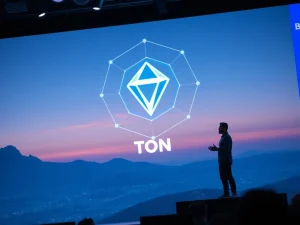Decoding the Kaito AI Airdrop: Navigating Tokenomics and Early Selling Fears

The crypto sphere is buzzing with the latest AI-driven project, Kaito AI, and its highly anticipated airdrop. Imagine getting free tokens simply for being part of a promising new ecosystem! Kaito AI has earmarked a significant 20% of its total token supply for airdrops and various community incentives, instantly grabbing the attention of crypto enthusiasts and AI aficionados alike. But amidst the initial euphoria, whispers of concern are starting to circulate, primarily revolving around tokenomics and the looming possibility of early sell-offs. Let’s delve deeper into the Kaito AI airdrop, dissecting the excitement and addressing the emerging questions.
What is the Buzz About the Kaito AI Airdrop?
Airdrops in the crypto world are essentially free token distributions, often used as a marketing strategy to build community, reward early adopters, and decentralize token ownership. Kaito AI’s decision to allocate a substantial 20% of its token supply to airdrops is a bold move, signaling a strong commitment to community growth and engagement. This significant percentage immediately positions the Kaito AI airdrop as a noteworthy event in the current crypto landscape.
Here’s why a 20% airdrop allocation is significant:
- Generous Distribution: A large allocation means a potentially wider distribution of tokens to the community, fostering decentralization.
- Incentivizes Participation: It strongly encourages users to engage with the Kaito AI platform and ecosystem to qualify for the airdrop.
- Raises Awareness: A substantial airdrop is a powerful marketing tool, creating significant buzz and attracting attention to the project.
However, such a large allocation also brings forth questions, particularly around the long-term sustainability and the potential impact on the token’s price.
Understanding Kaito AI Tokenomics: The Foundation of Value
Tokenomics, a portmanteau of ‘token’ and ‘economics’, is the study of the economic principles that underpin a cryptocurrency. It encompasses everything from token distribution and supply mechanisms to utility and incentives. Understanding the tokenomics of Kaito AI is crucial to assess the long-term viability and potential value of the tokens distributed in the airdrop.
Key aspects of Kaito AI’s tokenomics that warrant attention include:
- Total Token Supply: What is the total number of Kaito AI tokens? A clearly defined and potentially limited supply can contribute to scarcity and value appreciation.
- Token Distribution: Beyond the 20% for airdrops, how are the remaining tokens allocated? Understanding the distribution among the team, investors, and for other purposes is essential.
- Utility of the Token: What purpose does the Kaito AI token serve within its ecosystem? Does it grant access to features, facilitate transactions, or offer governance rights? Strong utility is a fundamental driver of token demand.
- Vesting Schedules: Are there vesting periods for team and investor tokens? Vesting schedules can prevent large dumps of tokens onto the market, stabilizing price.
While the announcement highlights the 20% for airdrops, a comprehensive understanding of the overall tokenomics structure is necessary to evaluate the long-term health of the Kaito AI ecosystem and the value proposition for airdrop recipients.
Early Selling Concerns: The Airdrop Double-Edged Sword
Airdrops, while exciting, often trigger concerns about immediate sell-offs. Recipients of free tokens might be tempted to sell them quickly to realize immediate profits, especially if they perceive the project as having short-term potential or if they are simply looking for quick gains. This phenomenon, known as ‘dumping’, can put downward pressure on the token’s price, especially in the early stages after the AI airdrop distribution.
Several factors contribute to potential early selling pressure:
- Free Tokens: Recipients haven’t invested capital to acquire these tokens, reducing their incentive to hold long-term.
- Profit Maximization: Some participants join airdrops solely to sell the tokens for profit, regardless of the project’s fundamentals.
- Market Volatility: The inherent volatility of the crypto market can incentivize recipients to sell quickly, fearing potential price drops.
- Uncertainty about Project Success: If recipients are unsure about Kaito AI’s long-term prospects, they might prefer to secure profits immediately.
The extent of early selling will depend on various factors, including the overall market sentiment, the perceived strength of Kaito AI’s project, and the distribution strategy of the airdrop itself. If airdrop participants are genuinely interested in Kaito AI’s vision and believe in its potential, they are more likely to hold onto their tokens, mitigating sell-off pressure.
Addressing Insider Allocation and Transparency
Alongside early selling concerns, questions regarding insider allocation are also surfacing. Transparency in token distribution is paramount for building trust and credibility within the crypto community. Concerns arise when there’s a lack of clarity about how many tokens are allocated to the team, advisors, or early investors, and what vesting schedules are in place.
To alleviate these concerns, Kaito AI should prioritize transparency by:
- Publishing a detailed token distribution breakdown: Clearly outlining the percentage allocated to each category (team, investors, airdrop, community, etc.).
- Disclosing vesting schedules: Making vesting periods for team and investor tokens publicly available.
- Communicating the rationale behind token allocation: Explaining the strategic decisions behind the distribution model.
- Engaging with the community: Actively addressing questions and concerns related to tokenomics and distribution.
Open communication and proactive transparency can significantly build community confidence and mitigate fears of unfair insider advantages.
Navigating the Kaito AI Airdrop: What Should Participants Consider?
For those interested in participating in the Kaito AI airdrop, here are some actionable insights and considerations:
- Research Kaito AI: Thoroughly understand the project’s goals, technology, team, and roadmap. Assess its long-term potential beyond just the airdrop.
- Understand the Airdrop Mechanics: Learn the specific requirements to qualify for the airdrop. This might involve tasks like social media engagement, platform interaction, or holding specific tokens.
- Assess Token Utility: Evaluate the utility of the Kaito AI token within its ecosystem. Does it offer tangible benefits or is it primarily speculative?
- Manage Expectations: Be realistic about the potential value of the airdropped tokens. Airdrops are not guaranteed paths to riches, and token value can fluctuate significantly.
- Stay Informed: Keep up-to-date with official announcements from the Kaito AI team regarding the airdrop and tokenomics.
Conclusion: Balancing Excitement with Realistic Expectations
The Kaito AI airdrop is undoubtedly generating significant excitement within the crypto community, fueled by the project’s AI focus and the substantial 20% token allocation. However, alongside the enthusiasm, it’s crucial to approach this opportunity with a balanced perspective. Understanding the intricacies of Kaito AI’s tokenomics, acknowledging the potential for early selling pressure, and emphasizing the need for transparency are vital steps in navigating this airdrop effectively.
Ultimately, the success of the Kaito AI project and the long-term value of its token will depend on its fundamental strengths, its ability to build a thriving ecosystem, and its commitment to transparent and community-centric practices. As with any crypto investment or airdrop participation, thorough research, realistic expectations, and a nuanced understanding of the underlying dynamics are paramount.









